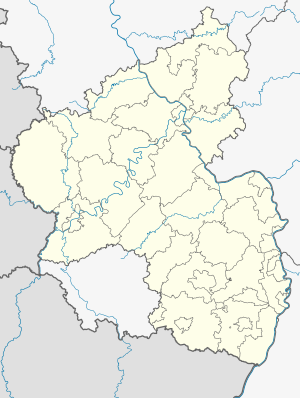Mainz mountain tunnel
| Mainz mountain tunnel | ||
|---|---|---|
| use | Railway tunnel | |
| traffic connection | Mannheim – Saarbrücken railway , Palatinate Ludwig Railway | |
| place | Bad Dürkheim | |
| length | 212 m | |
| Number of tubes | 1 | |
| construction | ||
| Client | Palatine Ludwig Railway Company | |
| start of building | 1845 | |
| business | ||
| operator | Deutsche Bahn | |
| release | August 25, 1849 | |
| location | ||
|
|
||
| Coordinates | ||
| Northwest portal | 49 ° 24 ′ 41 " N , 8 ° 0 ′ 26" E | |
| Southeast portal | 49 ° 24 ′ 36 " N , 8 ° 0 ′ 34" E | |
The Mainzer Berg Tunnel is one of a total of twelve tunnels on the Mannheim – Saarbrücken railway that emerged from the Palatinate Ludwig Railway . Originally laid out as a single track, the line was expanded to double tracks a few years later.
Geographical location
The tunnel is located between the Weidenthal and Neidenfels stops on the district of Bad Dürkheim , the settlement area of which is several kilometers to the northeast. It crosses under a foothill of the eponymous Mainzer Berg . It is used to shorten a loop of the Hochspeyerbach , which, together with the federal highway 39 , is bridged twice by the railway line both directly after the south-east portal and after the north-east portal.
history
On December 21, 1837, the Bavarian King Ludwig I gave the green light to the construction of a main line in an east-west direction from the Rheinschanze to Bexbach . Between Neustadt and Frankenstein numerous hills and foothills had to be overcome for the ascent. Among them was the Mainzer Berg, whose southwestern foothills stood opposite the planned route like a wedge. This required the construction of a 212 meter long tunnel in this area. Traffic from Ludwigshafen to Neustadt had already been opened in 1847, and in 1848 the Homburg – Frankenstein section followed in two stages . On August 25, 1849, the gap between Frankenstein and Neustadt including the Gipp tunnel was closed. Carriages had previously taken over the traffic between the two sections of the route. In July 1856, the Ludwig Railway was then consistently double-tracked.
Since the main line from Mannheim to Saarbrücken has always been of great importance for long-distance traffic, it was gradually electrified from 1960. The Gipp tunnel had to be widened for electrification. This delayed the completion of the electrical operation, which could finally be started on March 12, 1964 on the entire length.
literature
- Heinz Sturm: The Palatinate Railways (= publications of the Palatinate Society for the Advancement of Science. Volume 53). New edition. pro MESSAGE, Ludwigshafen am Rhein 2005, ISBN 3-934845-26-6 .
Individual evidence
- ↑ Heinz Sturm: The Palatinate Railways . 2005, p. 53 .
- ↑ Heinz Sturm: The Palatinate Railways . 2005, p. 96 .
- ↑ Heinz Sturm: The Palatinate Railways . 2005, p. 113 ff .
- ↑ Heinz Sturm: The Palatinate Railways . 2005, p. 146 .
- ↑ Fritz Engbarth: From the Ludwig Railway to the Integral Timed Timetable - 160 Years of the Railway in the Palatinate . 2007, p. 23 f .
